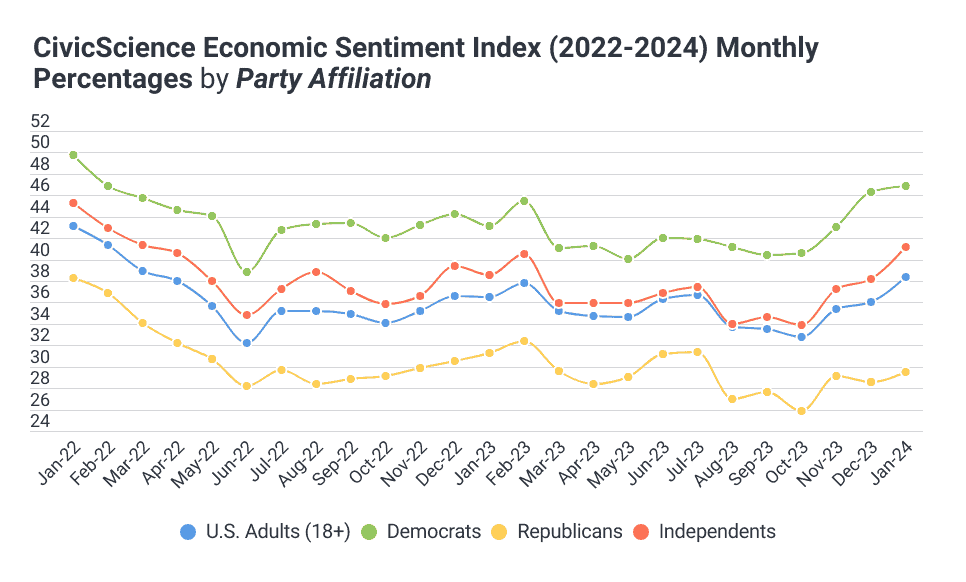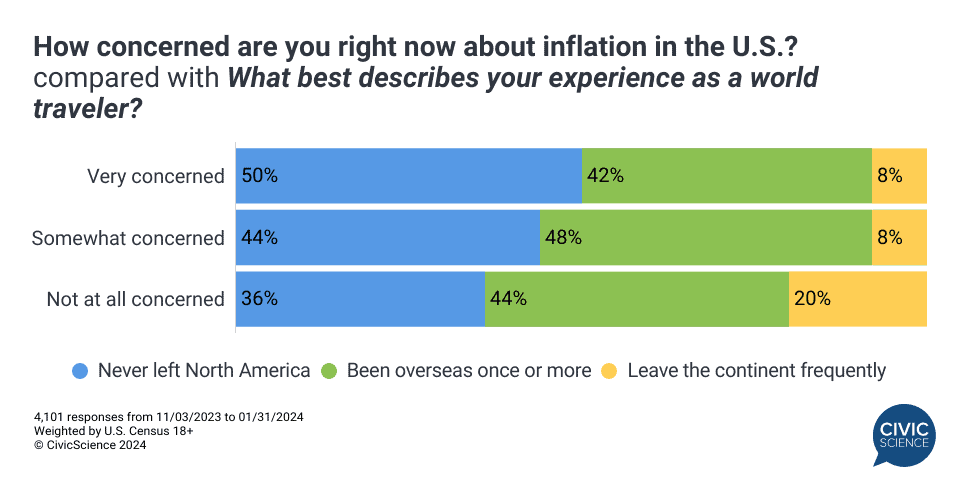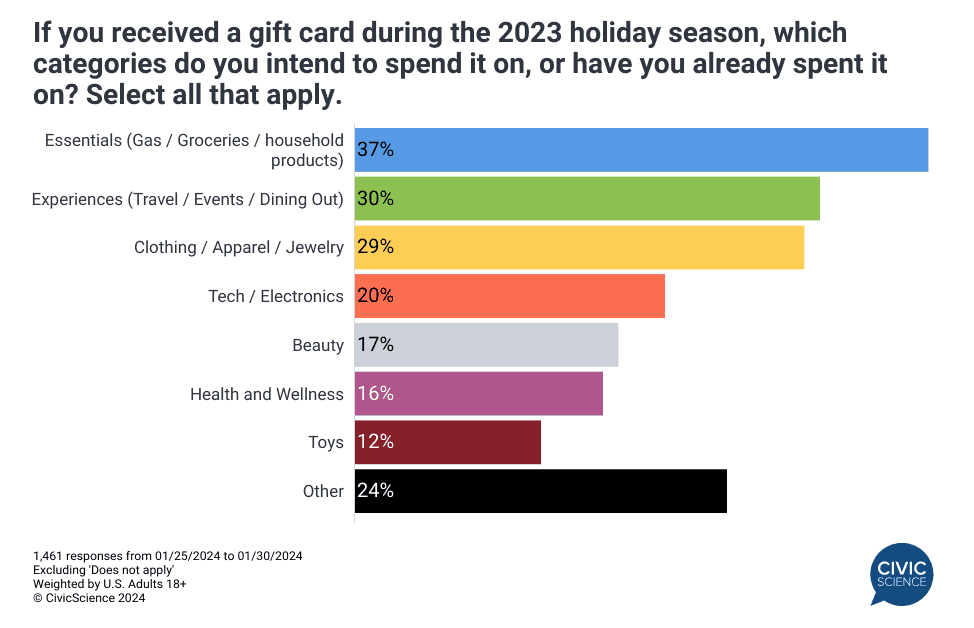We basically have three different economies right now.
There’s the right-leaning economy, the left-leaning economy, and the real economy. Whatever economy you’re in depends on what news you watch.
The right-leaning economy is in a state of catastrophe. Inflation is still rampant. Gas prices and interest rates are too high. Nobody can afford a home. You can’t understand why anyone would vote to re-elect Joe Biden.
The left-leaning economy is rosy. Job numbers and GDP are great, inflation is plummeting, and consumer confidence has been on a meteoric rise. You can’t understand why Joe Biden’s approval rating keeps falling.
The real economy lies in the middle. It’s more nuanced, too hard to summarize in headlines, too neutral to drive clicks or campaign contributions. Nobody talks about it because nobody wants to listen.

To be fair, neither the right nor left arguments are wrong – they merely lack context.
Indeed, consumer confidence has been surging. Forgotten on the left, however, is that economic sentiment remains deeply depressed compared to its lofty heights of late 2019. Yes, the rate of inflation and gas prices are steadily subsiding. It doesn’t change the fact that costs at the grocery store and fuel pump are painfully higher than they were when Donald Trump was in office.
Employment numbers have been objectively fantastic (tech layoffs notwithstanding). But a frothy job market is partly a byproduct of an understaffed workforce (thanks in part to severe declines in legal immigration), which has also helped to drive up wages in categories like hospitality and food service, forcing companies to further raise prices. Economists will tell you wage increases don’t cause inflation. Restaurant owners will tell you otherwise.
The right-leaning economy has its own brand of partiality. Whether we should celebrate the recent slowing of inflation, fuel costs, or interest rates – or improvements in consumer confidence – is open to debate. It’s all relative.
What’s not open to debate is the extent to which the U.S. economy has outperformed the rest of the world in recovering from COVID’s inflationary aftershocks. Many on the right, though, don’t grade America on a curve (see also: gun violence), presuming they even follow international news or even set foot on foreign soil. America is one of one.

Alas, the political questions remain – not the least of which is whether Joe Biden deserves any blame or credit whatsoever for the economy. I’m a hard ‘no’ on both.
But I live in the middle. Nobody cares what I think.
Here’s what we’re seeing:
On that note, consumer confidence bumped its head on the ceiling this week. As I was writing the rant above, our latest Economic Sentiment Index was released, and it complicated the narrative even further. For just the second time since late October, our metrics fell in the latest reading, this time somewhat sharply. Personal financial optimism dropped the most – I guess the post-holiday credit card bills showed up. It’s otherwise hard to explain, given the wealth of positive economic news lately. This year is going to be a ride.

In happier news, people are – well – happier. Our monthly Emotional Well-Being Index for January regained most of the ground it lost at the beginning of the Israel-Hamas War. While our collective stress remains heightened, feelings of sadness and fear have dissipated. The big news is that Americans are happy. In fact, we’re happier on average than we’ve been since the summer of 2021 (when COVID vaccines hit the streets). All it took was for Taylor Swift to attend a couple football games.

Facebook users are the most worried about misinformation. In our 3 Things to Know this week, we learned that a whopping 76% of Americans are worried about the spread of fake information heading into the election. Among regular social media users, Facebookers are by far the most concerned – because they’re old (like me). We also found that people really don’t like the experience of picking up their prescriptions at a big-box chain or grocery store. And 16% of people plan to stream the Super Bowl on Paramount+.

Job searching is on a slight uptick, particularly among people looking for remote or hybrid work. The percentage of U.S. adults who say they’re looking for a new job (or planning to) increased a couple of points since September. Job-seeking notably over-indexes among young people (40+% of workers aged 18-34 are looking). What’s perplexing about the data is that people who are happiest in their current job prefer working full-time in the office. But the people looking for jobs vastly prefer remote or hybrid employment.

People are still sitting on a ton of holiday gift cards and are planning to use them for necessities. Fifty-eight percent of Americans received at least one gift card during the holiday season (1/3rd received multiple). These cardholders skew younger, as you might expect. Spending them on essentials like groceries, gas, or household products is most popular, although it’s pretty well divided. Among holiday gift card recipients, a whopping 80% still have cards they haven’t used, and a large percentage likely never will.

More awesomeness from the InsightStore:
- Americans’ views on AI are complicated;
- Gen Z drove the mocktail craze during Dry January;
- Domino’s customers prefer Starbucks over Dunkin’, chain hotels over independents, and a few other insights.
The most popular questions this week:
Do you prefer buying clothes in person or online?
How adventurous an eater are you?
Do you generally prefer sweet or savory comfort foods?
What’s your ideal summer vacation?
Are you superstitious when it comes to your favorite sports team?
Answer Key: Even if CBS has to build a teleporting machine, she’ll be there; In person; 8 out of 10; Savory all day; Beach; Very.
Hoping you’re well.
JD
Sign up for a free seven-day trial of our Sage AI-powered consumer analytics assistant, which lets you explore our database of 5+ billion insights and 600,000+ questions.
Was this email forwarded to you? Sign up here. If you are new to this list, check out our Top Ten to get caught up.








